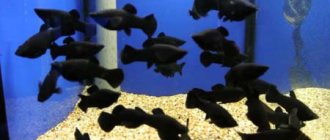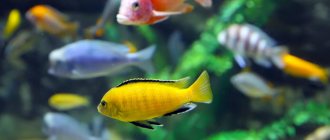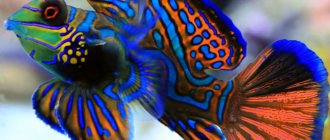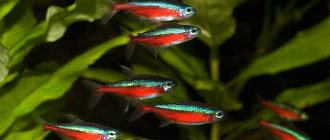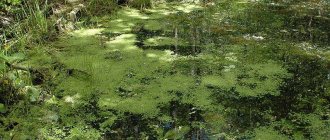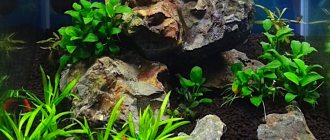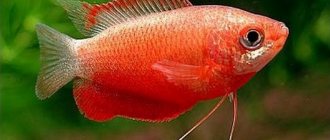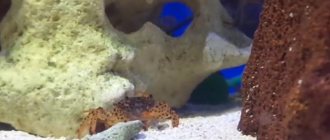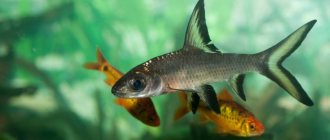Home › Aquarium fish ›
( 3 ratings, average: 3.67 out of 5)
Home aquariums most often contain small or medium-sized aquarium fish. This is because regular small tropical fish do not require much space, which is very convenient if you live in a small apartment. However, big fish also have their fans; and there are not just big ones, but also very big ones, large aquarium fish, and even huge ones. To maintain them, large aquariums are also needed: from 50 liters per fish or more. I suggest you study the TOP list of the largest aquarium fish, and you will simply be amazed at how big they can be.
The top includes only freshwater aquarium fish, calm and aggressive, predatory, tropical and cold-water.
Cichlazoma diamondata
The body of the diamond cichlazoma is strewn with bluish scales, thanks to which it seems that the fish is strewn with diamonds. In nature, the cichlid lives in North America, in the state of Texas and the northern part of Mexico, so it has another name - Texas cichlid. The body of the diamond cichlazoma is large, wide, oval-shaped, up to 30 cm in length. Lives in an aquarium for 10-15 years. It feeds on a wide variety of foods: worms, insects, crustaceans, plant foods. An aggressive, territorial aquarium fish with a bad character and often outrageous behavior: it often quarrels with its neighbors, is belligerent towards them and can create a mess in any, even the most beautiful aquarium - it loves to dig the soil. The diamond cichlid is often said to be a true Texan.
Managuan cichlid or Jaguar cichlid
The jaguar is a large cichlid that lives in the waters of Central America. Females of Managuan Cichlazoma grow up to 30 cm, males are larger - up to 35 cm. This is a very dangerous predator, feeding mainly on small fish and large invertebrates. Lives in warm climates and prefers warm water. A very popular species among aquarists who love large fish. The color of the Managuan cichlazoma resembles the pattern on the skin of a jaguar, hence the name. And the cleaner the water in the aquarium, the brighter and more beautiful the picture.
To keep a Jaguar cichlid you need an aquarium with a volume of at least 450 liters. These fish live up to 15 years.
Danio
Danio malabar
Malabar Danio is a calm and peace-loving fish
The largest of all zebrafish (up to 15 cm). A peaceful and calm fish, very rarely found among hobbyists.
Colors can range from green to blue. They do not require special care, the main thing is that the water is clean.
Danio leopard
The leopard danio is colored in the form of dots on an orange background, which resembles a leopard
An artificially bred hybrid from zebrafish. It is colored in the form of dots on an orange background, which resembles a leopard.
Easy to grow and does not require special attention.
gold fish
The common goldfish is a descendant of the wild carp, native to Asia. It is cold-water, so it needs a separate unheated aquarium with a water temperature of 18 - 22°C. On average, it grows up to 20 cm in an aquarium, but give this fish enough space and it will reach 30 cm. There are known cases where goldfish grew up to 45 cm in length. To keep these fish you need sufficient space: from 50 liters of water per individual.
Goldfish are also long-lived. Under good conditions and regular care they can live from 20 to 40 years.
Akara turquoise
A miniature artificial pond is not suitable for keeping turquoise acara. The length of adult individuals is about 30 cm. Therefore, if you need to place a couple of fish, you should choose containers with a volume of more than 300 liters. It is very sensitive to water quality.
Representatives of this family come from South America. Average life expectancy is 8 years. They have an incredibly beautiful silver-gray color, bluish-green scales, located throughout the body. The unusual coloring harmoniously combines with the wide yellow edging of the fins. A distinctive feature of males is the presence of a pronounced fatty lump.
Individuals are distinguished by interesting behavior. Turquoise Akara has become famous for its increased aggressiveness. That is why its second name is “green terror”. For this reason, you should carefully select your roommates. Ideal options are sized catfish or other cichlids.
Females behave completely differently after mating; they simply amaze with their well-expressed parental instinct. They incubate the eggs in their mouths until the fry hatch. They care for the offspring until they learn to feed themselves.
Akara turquoise
Shark Ball
Baloo shark is a relatively large freshwater fish, up to 35 cm in size, native to Southeast Asia. It is also called the silver baloo or silver shark - in appearance the fish really looks like a shark. The body of the balu is elongated, like that of a shark, but its dorsal fin especially resembles a predator. However, the resemblance to a shark ends there - the shark baloo is a fairly tolerant aquarium fish. Sometimes it can swallow smaller fish, so it is better to choose fairly large neighbors.
Sharks are excellent swimmers, so they need a long, spacious aquarium to keep them. A container with a length of 1.5 meters and a volume of at least 500 liters is recommended. Shark balus live 8-10 years.
Viviparous
Guppy
Guppies are the most popular aquarium fish.
Guppy fish are the most famous representative of viviparous fish.
The appearance of these small (up to 5 cm) fish is very difficult to describe, since they often interbreed, forming different shades of silver and golden colors.
These aquarium fish, photos with names of which are most recognizable to beginning aquarists, can boast of excellent fertility and unpretentiousness.
sword bearer
The swordtail is perhaps the second most popular aquarium fish after the guppy.
It got its name from the long growth on the caudal fin of males. The colors of these fish vary, but are always bright.
Excellent reproduction and unpretentiousness are a distinctive feature of swordtails.
Tiger Astronotus
Astronotus are extremely popular aquarium fish known for their intelligence and social behavior. Since these are very large (up to 45 cm) and aggressive fish, not everyone will dare to keep them, especially since it is quite difficult for them to find suitable tankmates, so it is recommended to keep them in a species aquarium. However, if you decide on a large capacity and regular labor-intensive care for astronotuses, they will very quickly win you over with their complex behavior. You can watch them for hours.
To keep astronotuses, you need an aquarium with a volume of at least 200 liters; an adult pair of fish requires 500 liters. They live 10-13 years.
Pterygoplicht brocade
Pterygoplicht brocade, or giant sticky catfish, is one of the largest representatives of its family. The body size from the tip of the tail to the head can reach 50 cm.
Pterygoplicht brocade
Note ! Despite its size, it is a herbivorous catfish, which means it will not hunt its neighbors in the aquarium. The minimum volume of the tank for keeping pterygoplichts is 250 l.
Plecostomus
The aquarium catfish plecostomus is one of the most famous and popular large catfish. Plecostomus grows up to 60 cm in length. In nature, it lives in South America, in the reservoirs of the Amazon basin. It feeds on algae and is therefore known as the algae-eating catfish. For a large aquarium, plecostomus is an excellent choice - it cleans well both from the remains of uneaten food and from algae growth. This catfish has a mouth in the form of a suction cup, so it can attach itself to the surface with its help. A very hardy fish, and if you give it 75 liters of space per fish, will live 10-15 years in a home aquarium.
Other large aquarium fish
In addition to catfish, there are also a sufficient number of different large fish. We will talk about the most popular representatives further.
Arowana (Osteoglossum bicirrhosum)
It is popular in the East. Despite the fact that in the natural environment the fish grows to a length of more than 1 meter, in aquariums its size is smaller. While swimming, its movements resemble those of a snake. The female grows larger than the male.
Arowana eggs are incubated in the mouth, and the male does this for 1.5 months. After this time, he releases the fry, which at this time grow up to 8 cm. Due to the aggression of these fish, they must be kept separately or in company with larger species.
There should be a minimum amount of decorations in the aquarium to make it easier for residents to swim. These fish are predators and feed on fish, lizards, shrimp and large insects.
Did you know? Contemplating fish calms your nerves. There is even a type of psychological help based on this,
-
animal-assisted therapy.
The water should be slightly acidic, its recommended temperature is more than +25 °C. The aquarium should have a tight-fitting lid with good filtration.
Mastacembelus erythrotaenia
Homeland is Thailand and Malaysia. Externally, this fish resembles an eel. Its body is elongated and covered with small scales. There are sharp spines on the back. At the bottom of the head there is a proboscis with nostrils, which is used to search for food.
Unlike other fish, Mastacembelus lack pelvic fins. Their body color is dark brown with longitudinal stripes of bright color, as well as red spots. Females are slightly paler in color than males. The fish grows up to 50 cm in length.
Mastacembelus is nocturnal. They show aggressiveness towards members of their own species.
For a full life of one individual, an aquarium with a volume of more than 300 liters is needed. At the bottom there should be sandy soil with a layer of 5 cm, as well as shelters from inverted ceramic pots, rock fragments and thickets of hard-leaved plants.
The temperature should be up to 28 ° C. Filtration needs to be powerful, and these fish love current. Mastacembelus can be given any live food as food. The fish reach sexual maturity at the age of 2 years.
Important! When caught in the hands, the fish tends to slip out and can prick with sharp spines. They are not poisonous, but the mucus that is produced by the body to reduce friction is toxic. To avoid problems, the injection site is immediately treated with an antiseptic.
Pseudoplatystoma fasciatum
In the wild, these fish live in the rivers of South America, as well as Peru and Venezuela. The main color is gray, along the body there are thin vertical stripes of dark color, which change their orientation closer to the tail, becoming horizontal. There are dark spots on the fins.
The fin on the back is sharp, and on the tail there is a large notch - the calling card of this species. The fish has no scales at all, therefore, it can be injured by sharp objects located in the aquarium.
This type of catfish is predatory. In aquariums they grow up to 90 cm. Like other representatives of this species, pseudoplatistomas are active at night. Its aggression and fairly large size make it quite a rare specimen among those chosen by amateur aquarists.
One fish needs at least 500 liters of water. It is recommended to place coarse river sand or fine polished gravel at the bottom. For decoration, large flat stones or driftwood are used: everything must be well fixed.
The water temperature that is comfortable for such fish is +25 °C. The aquarium must have powerful filtration and aeration. Individuals can only live with fish of the same size.
Freshwater moray (Gymnothorax tile)
The fish has slightly bulging eyes and a snake-like body. It is important to understand that, despite the name, these individuals need a little salty or sea water: this is the only way they will feel good and live on average 10 years.
Despite their tough look, moray eels are very shy. Even the usual rearrangement of decorations in the aquarium can cause them stress. As a result, the fish will refuse food for several days and behave unnaturally.
To prevent the activity of the moray eel from jumping out of the aquarium, you need to take care of durable glass on top. In addition, it is important that there are many caves and crevices at the bottom, swimming between which the moray eel can hide.
The capacity of the aquarium for one adult should be approximately 120 liters, because it can grow up to 60 cm in length. Since they produce a large amount of waste, it is necessary to provide the water with good filtration and change it regularly.
The diet of the fish described should consist of various marine foods. They are fed 2 times a week, and any leftovers must be removed. Freshwater moray eels can live in small groups.
Turquoise Acara (Andinoacara rivulatus)
The homeland is the north of Peru and the western part of Ecuador, the fish lives near the coast. A distinctive external feature is the occipital hump. Females grow slightly shorter in length than males - up to 15–20 cm.
The body color is turquoise with black speckles on each scale, the same pattern continues on the fins. There is an orange border on the dorsal and caudal fins. This type of aquarium fish is not picky about food.
The minimum volume of the aquarium for one fish should be more than 300 liters. A sandy substrate is poured onto the bottom, driftwood, stones and artificial vegetation are installed: everything must be carefully secured. Fish love dim lighting.
The water temperature should be above +25 °C. In addition, you cannot do without high-power filtration and regular cleaning of the aquarium.
The turquoise acara is very aggressive and attacks all its neighbors. For the normal life of different fish, only a very large tank of water is suitable.
Cichlasoma severum, or false discus (Cichlasoma severum)
Cichlazoma naturally lives in the northern part of South America. It differs from other fish in its high and at the same time elongated body, which is also compressed on the sides. The fish grows up to 15 cm in length. Its head is large with large eyes.
The dorsal fin is long. The body color is greenish-brown. All scales have bright spots of yellow, pink or red-brown color. There are dark round spots at the base of the dorsal and anal fins. A sexual difference is the presence of bright spots on the head of males.
Cichlazoma is peaceful and can only show aggression during spawning and caring for offspring. They live in the lower part of the aquarium. One fish needs at least 200 liters of water. The tank must necessarily contain driftwood, stone structures, caves and hard-leaved plants in pots.
Recommended water temperature is +22–24 °C. Like other fish, your aquarium needs good filtration.
This cichlid can feed on both live and plant food. Sexual maturity is reached at the age of 2 years.
Diamond or pearl cichlasoma (Cichlasoma cyanoguttatum)
This cichlid lives in Central America. The body of the fish is elongated, has flattening on the sides, and its back is high. The forehead line rises up, the eyes are large. The dorsal fin is long. Body color ranges from dark brown to olive. It grows up to 15 cm in length.
Despite the fact that cichlazoma lives in groups, the males are quite aggressive towards each other; they can only get along with larger representatives of other species. For one fish you need at least 100 liters of water, the temperature of which is +22–26 °C.
The aquarium should have different shelters, floating plants, and a powerful filter. Water changes should be 30% every week.
The fish eats a variety of foods, as well as substitutes. Reaches sexual maturity at 13 months.
Important! The fish species in question is prone to gaining excess weight, which negatively affects their health. To prevent them from overeating, you need to feed them often, but in small portions.
Bee cichlasoma, or biocelatum (Nandopsis octofasciatum)
One of the most interesting cichlids. Lives in swampy areas of North and Central America. This fish has an original color: the body is almost black, completely covered with bright turquoise spots.
The dorsal fin is decorated with a red border. The adult size is 17 cm. The male grows larger than the female.
For a full life, cichlazoma needs at least 150 liters of water. If there is more water, you can place other residents, who must be moderately aggressive.
There should be shelters made of snags and stones in the water, but there should also be sufficient space for swimming. The temperature regime suitable for individuals is +23–30 °C. In addition, filtration and aeration must be present.
The diet of cichlases consists of live food, frozen food, minced vegetables, shrimp, granules and flakes. In this case, plant food should predominate.
Astronotus oscarus, or ocellated astronotus (Astronotus ocellatus)
It is one of the popular aquarium fish of the Cichlid family. Their homeland is the tributaries of the Amazon, but today such fish can be found in natural reservoirs of Australia and the USA.
Astronotus are large fish, their body is oval in shape and their head is large. In an aquarium they grow up to a maximum of 28 cm.
Did you know? The Astronotus species was discovered in the 19th century. Today they can be found in almost every country as aquarium fish.
In captivity, these individuals can live up to 15 years with good care. Their color ranges from brown to grey-olive, with red-orange spots scattered throughout the body. At the base of the caudal fin there is a large black spot with a yellow border, visually reminiscent of an eye.
For a full life, one fish needs at least 100 liters of water. It is recommended to use coarse gravel as soil. To bring the situation closer to nature, you need to install driftwood and branches. It is better to make the lighting dim.
These fish are heat-loving; their comfortable temperature range is +23–28 °C. The filter must be very good, as harmful compounds can accumulate in the water, which will lead to health problems.
Uaru (Uaru amphiacanthoides)
These fish naturally inhabit the northern part of South America. In captivity they grow to a maximum height of 17 cm. The body is ovoid in shape, strongly compressed from the sides. The back is dark olive, the side is gray-yellow, and in this part there is a long dark spot running through the entire body.
The fins are gray-blue with a green sheen. The eyes are small and rimmed with orange.
One fish needs a minimum of 80 liters of water. These individuals are quite peaceful and like to live in small groups. They live at the bottom of the aquarium and love to eat plants. The water temperature required for keeping uaru is at least +26 °C. Lighting should be diffused.
It is important that there is a lot of decorations and at the same time enough space for free swimming. Live and frozen food can be used as food; plant foods can be used as additives. It is necessary to ensure that the fish do not experience hunger.
Clown botia (Botia macracanthus)
In its natural environment, the botia lives in ponds with dense vegetation, which are located in Southeast Asia and Indonesia. The body of this fish is elongated, slightly rounded, and has a magnificent color.
The body color ranges from yellow to orange-red, and there are three black stripes across the body. The clown loach has large eyes without skin, with sharp spines underneath them. There are 4 pairs of whiskers around the mouth. It grows up to 30 cm in length. It is important that there are no sexual differences in individuals.
These fish are kept in a container of 200 liters or more, the light should be dim. The aquarium should contain large quantities of decorations. Having decided to get this fish, it is important to remember that they live only in schools of 5-7 individuals, and die alone. The water temperature should be between +25–29 °C.
Filtration and aeration are also important for botia. They eat both live and dry food.
Did you know? The aquarium was invented by the English scientist H. Ward in 1841.
Botia clown
Clown botia comes from Indonesia. It’s hard to believe, looking at this large, beautiful aquarium fish, that in its homeland it is enjoyed as food. These are active fish with a striped orange-black body and red fins, growing up to 50 cm in length. A peaceful fish that gets along with almost any aquarium inhabitants, very funny and interesting. It will also help get rid of some overgrown snails. This is a schooling fish, it loves to be in the company of its own species, so there should be 3 or more of them in the aquarium.
To maintain you will need an aquarium of 300 liters, they live 10-20 years.
Angelfish
They have a non-standard body shape, very similar to a crescent moon. Large aquarium fish, thanks to their flattened shape, easily hide in the green spaces of their shelter. Angelfish are invisible due to the transverse stripes of their color. A reverent attitude towards their offspring, unpretentiousness, livability, grace and beauty of scale colors have become the key to the demand for this breed of fish. Breeders have created several species of this large aquarium fish.
Angelfish are predators that are ready to eat the fry of other fish. They are fed with live food - tubifex, bloodworms, daphnia, mosquito larvae. The diet must be strictly maintained within the norms for each species. Due to overfeeding, the fish will not be able to reproduce. In the ovaries swollen with fat, the caviar dissolves and reproductive ability ceases. During the spawning period, angelfish become aggressive. You can stop aggression only by placing the fish in another container. A special feature of angelfish is that they can try to reproduce even in the absence of males of their species in the aquarium. Same-sex couples are created, and the eggs remain unfertilized.
Aggressive large aquarium fish coexist more easily with other species if they have had a common maturation. But adult individuals will not be able to live with newly introduced newcomers.
Koi carp
Koi carp are peaceful large fish, although they will eat smaller slow-moving fish. They grow up to 90 cm in size. They live on average 20-30 years, but under good conditions they can live 50 years. With age, they begin to recognize their owners, and if you teach them, they will take food from your hands. To keep koi carps, you need a tank with a depth of at least 1 meter, and for one fish the volume of water should be 100 - 180 liters. They are more often kept in home ponds and swimming pools than in home ponds. Koi can live in a wide variety of water conditions.
Silver Arowana
Arowana is a very famous and popular large freshwater aquarium fish, also known as dragon fish and monkey fish. In nature, it lives in South America. Known for its large size and hunting abilities. This is an aggressive predator with an interesting way of hunting: the arowana hunts by jumping out of the water and grabbing insects from tree branches, while the fish jump quite high. Although more often it gets insects floating on the surface that find themselves in the water during the flooding period.
The silver arowana grows up to 120 cm in length, and to keep it you need an aquarium with a volume of at least 900 liters. Lives 10-20 years. Arowana is one of the largest aquarium fish
Tetradons
Tetradon dwarf
Tetradon dwarf is distinguished by the fact that it is able to move its eyes independently of each other
The smallest of all tetradons (2.5 cm). It has a very bright and attractive coloring.
Very smart fish, watching what is happening behind the glass of the aquarium. They differ in that they are able to move their eyes independently of each other.
The color varies according to mood from brown to green.
Redtail catfish
The redtail catfish is a large and very fast growing freshwater aquarium fish. In addition, this is one of the most attractive catfish. In nature, the red-tailed catfish lives in streams, rivers and lakes of the Amazon basin, throughout South America. Not suitable for keeping in most home aquariums, as it can grow up to 150 cm. But it can still be found on sale. However, a purchased fish 5 cm in length very quickly grows to a gigantic size, and most aquarists give catfish to public aquariums. Therefore, when purchasing a redtail catfish, think carefully about whether you are prepared to handle the care requirements. To keep red-tailed catfish, an aquarium with a volume of at least 3500 liters is required.
Red-tailed catfish live 15-18 years.
Brackish water
Splashfish
The squirt fish sprays a thin stream of water at insects, thereby knocking them down and eating them
Loves brackish water. It can spit a stream of water at insects, knocking them down and eating them.
The fish is silver in color with dark spots on the back.
It is quite difficult to keep and breed, so it is recommended only for experienced aquarists.
They get along well with other fish if they behave calmly.
Gar or armored pike
Gar is a large, predatory, freshwater fish. Most gars live in Central and North America, but are also widespread in South Asia: India, Malaysia, Sri Lanka. The North American relatives of the Asian gar are simply huge and can grow up to 3 meters in length. The alligator gar is the largest of the gars; it has a wide, elongated head, similar to the head of a crocodile, with rows of sharp teeth. South Asian gars grow only up to 1 meter in length. All gars have an elongated, needle-shaped head and sharp teeth. Small gars can be kept in a home aquarium, but larger fish are best left for public aquariums.
These fish have a special feature - a swim bladder that functions like lungs, so they can survive in bodies of water with little oxygen. Gars live 20-50 years.
Lepidosiren paradoxa "Gold")
Lepidosiren - or American scalefish, is a very unusual lungfish native to the reservoirs of America. Its peculiarity is the ability to breathe oxygen in the air and hibernate during the dry season. Lepidosirens grow over 1 meter and are a decoration for show aquariums! They have a long, powerful, rounded body covered with mucus instead of scales. The pectoral and anal fins have the form of cords. The eyes are very small and inconspicuous. The color of the fish is gray-brown, with yellow spots present in young individuals.
Despite its exoticism, lepidosiren is quite unpretentious. Among its neighbors it prefers the company of calm, large, non-aggressive fish. Can be combined with angelfish, discus, and stingrays.
